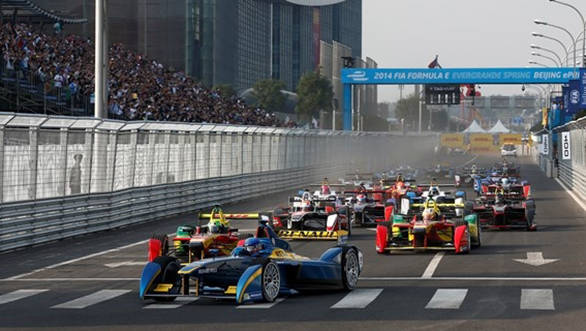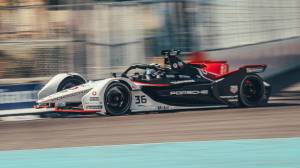Formula E: What the buzz is about?
Every time there's a new racing series that's about to start off, I find myself terribly conflicted. There's a part of me that is secretly doing cartwheels because I feel like more racing and more motorsport simply cannot be a bad thing. No no, that's putting it mildly. I truly believe that more motorsport is an exceedingly good thing because what it means is that there's a new series there for the many talented drivers, who are waiting in the wings for their big break, to finally hop in a racecar and go out there and prove themselves. But there's the other side of me that tends to ignore the silver lining and focus on the big black cloud of motorsport doom that I invariably see. I end up seeing a series that will flourish for a season, maybe two, and then vanish without a trace. Another 'once was' in motorsport archives that years from now we'll look at photographs of and say, 'It was a terrific series, if only they'd. . .'
Ever since I heard of Formula E kicking off, I'd viewed the championship with what I believed was an appropriate amount of skepticism. There were so many things that I was concerned about with regard to whether or not the series would succeed. First, there was that fact that when viewership numbers for a sport like Formula 1 are rapidly dropping, and when people are whining on and on about the lack of racecar growl in F1, what chance was there that they'd tune into a championship featuring all-electric cars, that aren't as fast as other single-seater championships? Ones that sounded stranger than the current lot of F1 cars that too. And I wasn't entirely sure that the grid of drivers that they had, despite the fact that 11 of them have competed in Formula 1 in the past, would quite draw in the fans. Of course, the championship negated the problem of empty grandstands, by choosing not to host the races at far off racetracks, but instead plonking the entire electric circus right in the middle of the city.
 Nico Prost leads the pack at the start of the race
Nico Prost leads the pack at the start of the race
Apprehensions and all, I found myself unable to sleep the night before the first Formula E race was set to kick off a combination of anticipation (those aforementioned cartwheels, dammit) and fear that I'd oversleep and miss the non-qualifying practice sessions. Fortunately I didn't. I followed the sessions online, watched qualifying and then waited for the race to kick off. When it did, I was pleasantly surprised - not ecstatic, but happy enough. The cars weren't the fastest - maximum power of 200kW is only available during practice and qualifying, while in race mode only 150kW is available - there's no pretending otherwise. But that didn't seem to come in the way of good racing. While the cars really appeared sluggish on the straights, they were skittish around the corners thanks to the fact that they weren't shod with slicks, which made for interesting watching. And even though we had pole man Nico Prost rushing off at the head of the grid and retaining that position all through, save for that ill-fated last corner on the last lap, there was overtaking aplenty up and down the order.
And that's really why we watch racing, isn't it? To see some terrific scraps as drivers go wheel to wheel, to see race machines grapple for position on track, and, to not know till the very last corner of the very last lap, who will win the race. The first Formula E race at Beijing, albeit by accident (full pun intended), delivered on all counts.
Not all my concerns about the series have vanished with this first race though. I'm still wondering about whether the best way to showcase to the world that electric cars are the future of urban mobility, is to have drivers doing speeds of around 180kmph for around half an hour, covering 43km and then have to come in to swap cars. But that's something that Formula E promises it will work on - a future where drivers will only use one car over the course of a single race. A friend and fellow motorsport hack pointed out to me the significance of Qualcomm as one of the partners of Formula E. They already have wireless charging pads for one of the BMW i3 course cars that do circuit duty during the e-prixs.
Someday, the plan is for the racecars to also come into the pits, get charged wirelessly, and then head back out on track. Of course, there are several more technological challenges that the nascent series is trying to sort out, like reducing the weight of the battery (300kg!), and heading towards a formula that is no longer single-make, with each team designing and building their own cars for 2015. But that's a long way off. I'd just like to see how the rest of the races in the championship's first season progress. If they can be as exciting as the first one, sure, I'd watch it. And I also like the single-day format of the race and that it's on a Saturday. I watch quali and soon after I can watch the race itself.
Throwback to Formula 1's Sunday qualifying days! So, will the series sustain itself? Well, it's early days yet. And there's no real way of knowing. However there are two major championships that are going green in a big way. The FIA put the 'e' in Formula 1 way back in 2009 when they introduced KERS.
And the ACO's rules have made sure Le Mans and the World Endurance Championship have gone green too with their hybrid regulations in the LMP1 class. And with major manufacturers and electric mobility houses already showing an interest in Formula E, there's every chance it just might work beyond the three years that it is already hoping to run. Maybe we can keep the gravestone on standby for this one, but I'm not ruling out already thinking up lines for the epitaph.













